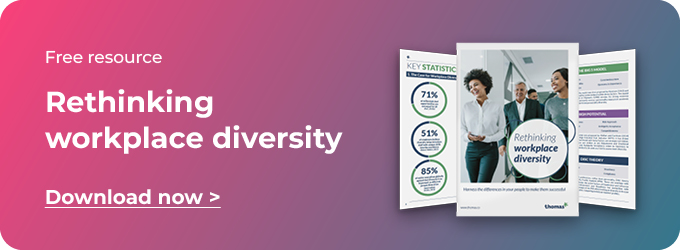Unconscious bias affects many aspects of daily lives. Think about the time you bought a car or something from a big retail giant like Amazon - we seek out the best reviews so that we can give ourselves a pat on the back for having made ‘the right decision’.
In the workplace unconscious bias can affect us in many different ways. One example is candidate selection. Even something as simple as a name can give a completely skewed idea into how well that candidate would perform. This will be based on prejudices, sexism and in some instances overt racism which affects a candidate’s chances of securing a position in the company.
Over the last few years, many companies and organisations have tried to undo this bias by undergoing Unconscious Bias Training (UBT) garnering criticism and controversy in some quarters. The UK Civil Service for example has scrapped UBT as it says “there is no evidence it changes attitudes.” This has equally been met with criticism from anti-racism campaigners asking the Government to not “backtrack on anti-racism training.”
In this guide we are going to take a closer look at what unconscious bias is, how unconscious bias training works and understand whether it is effective.
What is unconscious bias?
Unconscious bias, or 'implicit bias,' refers to prejudice or unbacked judgments favouring or against a person or group, resulting in unfair benefits or penalties. For example, a 2016-17 study found that fake job applicants with common Pakistani or Nigerian names had to send 60% more applications than those with stereotypically British names to get the same number of callbacks, despite identical qualifications.
Various types of unconscious biases impact businesses:
1. Affinity bias
This is an unconscious inclination towards people similar to us. It may cause managers to favour certain team members' opinions, limiting learning opportunities and fresh perspectives.
2. Attribution bias
This cognitive bias involves systematic errors when finding reasons for behaviours. In recruitment, it may affect an applicant's prospects based on something on their CV or unexpected interview behaviour.
3. Confirmation bias
It's our tendency to gather evidence that supports our existing beliefs, influencing how relationships are built or broken in workplaces.

4. Gender bias
It reflects favouritism based on gender, despite a gender-balanced workforce leading to better problem-solving and broader thinking.
5. Perception bias
This involves forming oversimplified stereotypes about certain groups, affecting decisions like hiring, promoting, advice-giving, and performance evaluations.
6. Halo effect
This is when one trait of a person influences overall judgments about them, leading to unequal employee treatment based on minor factors.
7. Ageism
Discrimination based on age could result in missed opportunities to benefit from older employees' experience or retain younger talent, leading to high turnover and less experienced teams.
For a more detailed explanation of the different kinds of bias, please see this article.
What is unconscious bias training?
To resolve the issues raised in the previous section, we may consider undergoing unconscious bias training as a way to combat all the different types of unconscious bias. Unconscious Bias Training (UBT) has become very popular in recent years to help people and organisations navigate the professional world in how we deal with our biases. In particular with unconscious bias training, the aim is to reduce people’s racist, sexist, ageist and homophobic biases. The idea is to reduce these biases so that someone's biases are less likely to change their thinking and behaviour.
What is involved in unconscious bias training?
It is essential to deliver unconscious bias training in a way that maximises its ongoing effectiveness and value to trainees. The following step-by-step guide outlines how best to deliver unconscious bias training.
Step 1: Introduction to unconscious bias
Start by defining unconscious bias and its influence on decisions and actions. Use examples, like perception bias, to illustrate how bias can occur without conscious realisation.
Step 2: Understanding the origins of unconscious bias
Help attendees pinpoint the roots of unconscious bias. Talk about factors such as a lack of diverse cultural exposure or negative past experiences that could feed bias. Invite participants to examine their own biases and comprehend their origins.
Step 3: Recognising and challenging unconscious bias
Teach participants how to identify instances when they might act based on unconscious bias. Share strategies for confronting and negating biased thoughts and assumptions. Create a secure environment for open dialogues and personal bias-related experience sharing.
Step 4: Reducing unconscious bias
Discuss techniques for mitigating unconscious bias at work. Organise workshops, one-on-one training, or group discussions to highlight bias's impact on teams and individuals. Equip employees with practical tools and resources to tackle bias in their roles and across the company.
Step 5: Customising training programmes
Highlight that unconscious bias training varies between organisations. Advocate seeking guidance and understanding the unique offerings of different training modules. Stress the need for customising the training to match the organisation's specific needs and context.
Step 6: Practical exercises
Incorporate exercises to solidify learning and heighten unconscious bias awareness. Examples include Harvard University's Implicit Association Test (IAT), measuring associations with different groups, and the TAG game, adapted from Fowler (2006), where participants form groups based on visual cues, not conversation.
Step 7: Evaluating the effectiveness
Debate the effectiveness of unconscious bias training and its impact on individuals and the organisation. Encourage trainees to provide feedback on the programme for continuous enhancements.

Is unconscious bias training effective?
To gauge the effectiveness of unconscious bias training, we must first identify our objectives, such as raising awareness of unconscious bias in our personal and professional lives or fostering more inclusive, bias-free workplaces. The training's success hinges on these defined goals. Throughout the training, we should gain an understanding of unconscious bias and its expected benefits. Here are some of the benefits of unconscious bias training:
Raised awareness of negative implicit associations
The more we become aware of the negative implicit associations, the more we will find ourselves correcting these attitudes and form a wider, more comprehensive understanding of the people we are working with.
Empower employees to share diverse perspectives
If we have struggled to understand or bridge the gaps with those we have little in common with, we can see in UBT employees of diverse ethnicities feeling more open to share their experiences so that we can gain a better understanding.
Reduced prejudice
We should also start to see reduced prejudice in the workplace and in our personal lives too - thanks to a heightened awareness of how this happens.
Improved recruitment and retention rates
There will be implicit benefits coming from the UBT in the recruitment area by simply widening the talent search. For example, the less prejudice there is towards someone's name, the more we get to see a candidate’s ability to perform the job in the skills that they have.
Greater innovation and creativity
Once again, this is thanks to people being given opportunities at the recruitment phase leading to new possibilities of giving those with different skill sets and experience an opportunity to shine. We know that the more diverse a workforce, the more productive and profitable a business will be.
It is important to remember that UBT must be presented in an unbiased way, and that it won’t resolve all the issues you may encounter with prejudice in the workplace. UBT should never be considered as a one-off training activity, because its purpose is to retrain the ideas and unconscious biases someone has held for a very long time. It needs to be regularly delivered to maintain the good work that it can do and equally form part of a larger training programme used to remove bias.
3 reasons why unconscious bias training doesn’t work
Following on from that last point about needing UBT to be successful, there has been a lot of criticism about the training and many questions raised whether it works or not.
The American Scientific Journal called it, “well motivated, but there’s little evidence that it leads to meaningful changes in behaviour.” There are a few key reasons why many believe that UBT doesn’t work. These include:
1. Lack of evidence in long term changes
The Implicit Association Test (IAT) which was developed by Harvard professor Edward Chang saw that participants were less likely to change their behaviour three weeks after training and within six weeks saw that those who took the training were less likely to have a different attitude when compared to those who didn’t take the training.
It remains the case that to this day, “none of the IAT interventions has been shown to result in permanent, long-term reductions of implicit bias scores or, more importantly, sustained and meaningful changes in behaviour (i.e., narrowing of racial/ethnic clinical treatment disparities).” This does lead to questions about how UBT can change perceptions over the long term, especially if training is only based on short-term or one-off sessions.
2. UBT done the wrong way can have negative consequences
There is a wider concern that UBT being administered incorrectly can have the opposite impact. Think of those “lukewarm” diversity training seminars that you are forced to sit through rather than want to sit through. These seminars can create anger and wider frustration amongst white employees as they can feel as if they are being called out as racist.
This calls into question whether or not implicit bias training is useful at best, at worst it could exacerbate the issues it is trying to resolve.
3. UBT can be seen to justify bad behaviour
Finally, there is a wider concern that UBT can be seen as encouraging bad behaviour - especially by those who take these short courses and then find ways to excuse their bad behaviour as an “involuntary act of bias”. No real change has occurred, but one main difference is that these people feel empowered to continue with overtly prejudiced views as some sort of knock back to those experiencing challenges.
Conclusion
Hopefully this guide has given you more insight into the world of unconscious bias and how to use tools such as UBT and IAT to help people understand and change their behaviours.
It is important to remember however that, it is simply not possible to change the bias of people but they can be provided with practices which improve equality and inclusion in the workplace.
The Thomas assessment suite of tools can be used to help with diversity in recruitment. With years of experience in psychological assessments and training packages, Thomas can help you recruit and build teams that are more inclusive and focus on behaviour, attitudes and skills. If you would like to learn more, please speak to one of our team.





